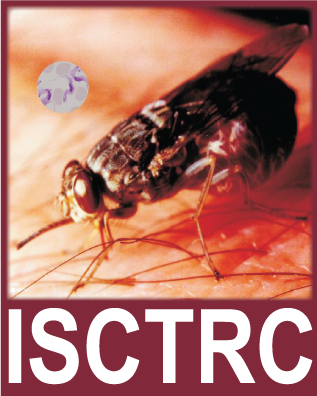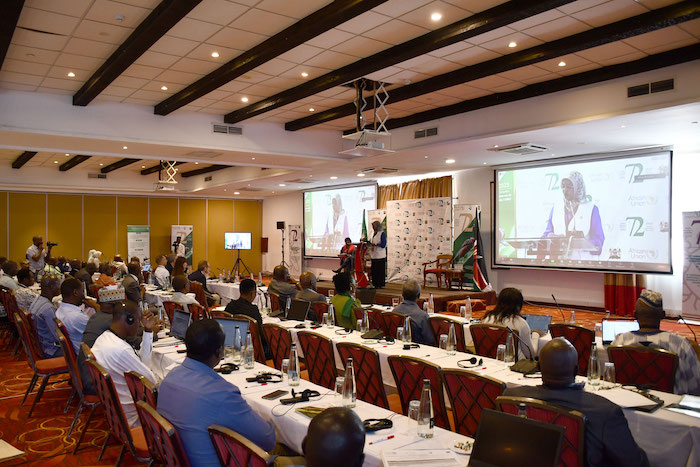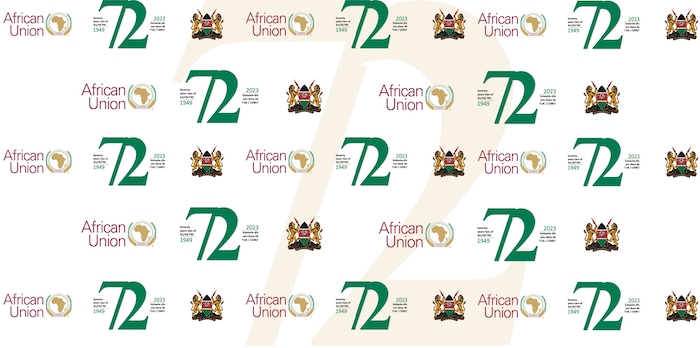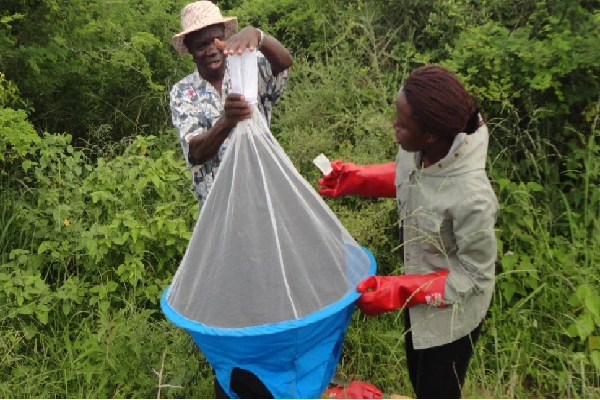International Scientific Council for Trypanosomiasis Research and Control

The African Union Interafrican Bureau for Animal Resources (AU-IBAR) is at the forefront of reducing the impact of transboundary animal diseases and zoonoses on livelihoods and public health in Africa. The prevention, control and eradication of the diseases is achieved through specific networks, platforms and projects within the framework of the Comprehensive African Agriculture Development Programme.
Rationale
Trypanosomiasis severely affects human and livestock health, limits land use thus causing poverty and perpetuating underdevelopment on the continent. The impact of the disease extends over 36 countries and an estimated 10 million sq. km (a third of the continent) of land area. The International Scientific Council for Trypanosomiasis Research and Control (ISCTRC) was established in the 60s on the realization that the removal of tsetse and trypanosomiasis required an international organization that would serve as a vehicle of cooperation and implementation across national, regional and continental barriers. ISCTRC is a statutory council of the African Union with the secretariat at AU-IBAR and is managed by an Executive Committee. It has continued to act as a platform for knowledge sharing and information dissemination on trypanosomiasis research and control.
Membership of the Council
Membership of the council is drawn from Member States, representatives of all international organizations and institutions working in the field of tsetse and trypanosomiasis, institutes in Africa engaged in tsetse and trypanosomiasis, representatives of regional and multilateral projects in Africa, funding and development agencies, members from other countries (as observers) where research on trypanosomiasis or related subjects is being carried out.
Membership of the Executive Committee
The ISCTRC is managed by an Executive Committee whose membership comprises of 2 members from each of the four regions: western, central, eastern and southern Africa; others are the Director of AU-IBAR, representatives of FAO, IAEA, WHO, ICIPE, ITC, ILRI, CIRDES, PAAT and PATTEC. The committee meets annually to organize the biennial scientific conference in addition to carrying out the Council's functions.
- Exchange and disseminate information through meetings and publications.
- Support capacity building efforts on tsetse and trypanosomiasis research and control.
- Provide scientific and technical support to African countries.
- Promote and encourage regional programmes.
- Implement regional programmes with AU-IBAR as a partner.
- Support integration of socio-economics and land use in tsetse and trypanosomiasis control activities.
- Identify knowledge gaps to increase capacity of experts on tsetse and trypanosomiasis research and control.
- Create awareness for demand-driven research.
- Biennial scientific conference to evaluate progress sustained since 1949.
- 2007: The ISCTRC Executive Committee recommends all necessary efforts to strengthen International Trypanotolerance Centre (ITC) in the Gambia.
- 2001: PATTEC launched during the 26th ISCTRC conference in Ouagadougou, Burkina Faso.
- 1999: European Union funded regional five-year Farming In Tsetse Controlled Areas (FITCA) project. Launched and implemented by AU-IBAR in 5 countries: Ethiopia, Kenya, Rwanda, Uganda and Tanzania.
- 1999: ISCTRC Executive Committee recommendation to Member States and international organisations to consider trypanosomiasis as an emergency contributed to the establishment of PATTEC.
- 1965: OAU (now AU) Heads of State took over the Commission for Technical Cooperation in Africa (CCTA) and was transformed into ISCTRC to be funded by Member States.
- 1949: Permanent Commission for Technical Cooperation in Africa south of the Sahara (CCTA) created by international organisations for research and control of trypanosomiasis held its first meeting in London, UK.
Some important developments and milestones in the History of the ISCTRC:
- 1948: West African Institute for Trypanosomiasis Research (WAITR) established at Kaduna Nigeria.
- 1949: 2nd – 8th February International conference in Brazzaville Recommendation to create a Permanent Central Bureau and International Scientific Committee.
- 1949: Establishment of the East African Trypanosomiasis Research Organisation (EATRO) with John Ford as the first Director at Kabete Kenya.
- 1950: First meeting of the International Scientific Committee. A Scientific Conference in Johannesburg recommended the setting up of a council for Africa South of Sahara. EATRO moved from Kenya to Tororo, Uganda.
- 1950: November - Scientific council for Africa South of the Sahara (CSA) established as Scientific Adviser to the CCTA to further the application of science to the solution of the African problems.
- 1951: January – establishment of the Commission de Coopération Technique en Afrique au Sud du Sahara (CCTA).
- 1954: 18th January – Inter-Governmental Agreement signed formalising CCTA.
- 1962: Rinderpest Control Campaign launched under the auspices of CCTA.
- 1963: Creation of the Organisation of African Unity. September- meeting of experts in Lagos.
- 1964: First Constitution of the ISCTR was published WAITR was dissolved by the Government of Nigeria and the Nigerian Institute for Trypanosomiasis Research (NITR) was established.
- 1965: January 1st CCTA to become an organ of the Organisation of African Unity (OAU). First meeting of the scientific, technical and research commission (STRC of the OAU. Decision for the ISCTR to be absorbed as an organ of the STRC.
- 1966: Kissi report recommending Joint Field Campaigns against Trypanosomiasis.
- 1969: November 26 – 27 Constitution of the ISCTRC was amended at the first meeting of the Executive Committee of the ISCTRC in Lagos, Nigeria.
- 1971: Recommendation that ISCTR be changed to ISCTRC to emphasise the need for control activities. Establishment of the International Centre for Insect Physiology and Ecology (ICIPE) in Nairobi Kenya.
- 1972: Establishment of International Livestock Centre for Africa (ILCA) in Addis Ababa, Ethiopia.
- 1974: World Food Conference in Rome initiated the Programme for the control of African Animal Trypanosomiasis and related Development.
- 1975: Establishment of the International Laboratory for Research on Animal Diseases (ILRAD) in Nairobi, Kenya.
- 1977: FAO/OAU/WHO Leadership Training Seminar held in Nairobi in collaboration with ILRAD. Dissolution of EATRO.
- 1978: September 10th FAO Regional Conference for Africa, Arusha, Tanzania.
- 1979: FAO/OAU/WHO Leadership Training Seminar held in Bobo-Dioulasso with collaboration of OCCGE. Launching of the tsetse and Trypanosomiasis Information Quarterly.
- 1980: First training courses for middle level technical personnel at the UNDP/FAO Tsetse Applied Research and Training Project in Zambia.
- 1981: Establishment of the international Trypanotolerance Centre (ITC) in Banjul, The Gambia.
- 1995: Formation of the International Livestock Research Institute (ILRI) headquarter in Nairobi, Kenya, and subsuming ILCA and ILRAD). Formation of the Programme against African Animal Trypanosomiasis (PAAT).
- 1998: The ISCTRC Executive Committee recommended that the project Planning and implementation (PPI) module of PAAT be incorporated into ISCTRC/IBAR. Establishment of the EU-Funded Concerted Action; a programme to coordinate activities and promote exchange of information regarding research into African Trypanosomiasis.
- 1999: August -The FITCA project officially launched at the Kenyan Border town of Busia, with the attendance of 4 Ministers and over 100 participants from the Region. September-ISCTRC recommendations of 25th ISCTRC Executive Committee warned member to consider trypanosomiasis as emergency that warranted immediate attention and asked the states and international organisations to give highest priority to trypanosomiasis control. The Secretariat committed to provide progress on these recommendations that contributed to the establishment of PATTEC in the next meeting.
- 2000: PATTEC Strategic Framework approach by Heats of States, in Lomé, Togo.
- 2001: PATTEC officially launched during the 26th ISCTRC conference in Burkina Faso.
- 2002: PMC committee for PATTEC established.
- 2003: PATTEC Coordination established in Addis Ababa. 27th ISCTRC Conference convened in Pretoria, South Africa.
- 2004: FITCA Project completed in December 2004. African Development Bank provides USD 70 million for PATTEC project in 6 African countries.
- 2007: The 29th ISCTRC Conference and 32nd Executive Committee meeting held in Luanda, Angola, for the first time to create awareness in one of the countries with the highest number of sleeping sickness and allocated a whole day for PATTEC implementing countries to present their progress before the representatives of member states to enable them to join.
| Attachment | Size |
|---|---|
| ISCTRC : Brochure (761.53 KB) | 761.53 KB |
| ISCTRC : Brochure (French version) (764.81 KB) | 764.81 KB |
| Attachment | Size |
|---|---|
| 32nd Conference of ISCTRC: Reports and Recommendation (247.29 KB) | 247.29 KB |
| 32nd Conference of ISCTRC: Reports and Recommendation (French version) (5.86 MB) | 5.86 MB |
| 31st Conference of ISCTRC: Reports and Recommendation (768.59 KB) | 768.59 KB |
| 30th Conference of ISCTRC: Reports and Recommendation (646.28 KB) | 646.28 KB |
| 30th Conference of ISCTRC: Proceedings - Publication n.125 (6.27 MB) | 6.27 MB |
| 29th Conference of ISCTRC: Proceedings - Publication n.124 (6.47 MB) | 6.47 MB |
| Secretariat report on implementation of various decisions of Council for strengthening ISCTRC (233.84 KB) | 233.84 KB |
| Attachment | Size |
|---|---|
| doc_20110922_isctrc_31stconference_programme_en.pdf (1008.52 KB) | 1008.52 KB |
| doc_20110922_isctrc_31stconference_programme_fr.pdf (1.04 MB) | 1.04 MB |




